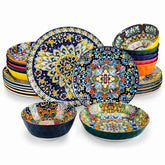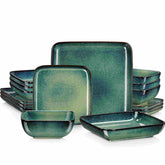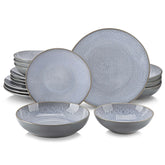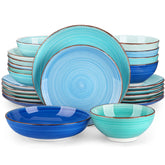Everything You Need to Know About Reactive Glaze Dinnerware
Navigation
- Introduction
- What is Reactive Glaze?
- The Creative Process
- History and Origins
- Unique Features of Reactive Glaze Dinnerware
- Benefits of Using Reactive Glaze Dinnerware
- Caring for Reactive Glaze Dinnerware
- Conclusion
Introduction
Reactive glaze dinnerware has become common in many homes in recent years. This kind of tableware is outstanding for its singular beauty and strong structure when used in either informal or formal places. However, what is reactive glaze really?
This article will be a revelation of the world of reactive glaze dinnerware and which covers its origin, characteristics that make it stand out, advantages, and tips on maintenance.
What is Reactive Glaze?
Reactive glaze is a ceramic glazing technique that produces an original, diversified surface. It significantly distinguishes itself by having unique aesthetics that are produced in a specialized way of glazing. Potters apply reactive glazes during the making of these objects that are seen to change when they are fired.
Thereby, they turn into various erratic designs and many colors; hence, every plate or bowl has its own unique look almost as if it were a piece of art. This process also adds functionality to the dinnerware not only does it enhance its look; but in most cases, several layers make it stronger and more resistant to chipping off.
That makes Reactive Glaze Dinnerware suitable for everyday use as well as for special occasions. As such it brings out stunning visuals made from natural sources and at the same time ensures durability in your kitchen collection.
The Creative Process
Reactive glaze is created in several steps. The first step is to apply the base glaze on the pottery and then add some extra chemicals to the surface.
At this point, these chemicals are reacted with base glaze during the firing process in a kiln due to its high temperatures resulting in unique patterning and coloring. This step takes much expertise and accuracy since it often has unpredictable but beautiful end products.
History and Origins
Reactive glaze dinnerware was first made by potters in the mid-20th century as a response to both artistic and practical requirements. This method combines the traditional ceramic glazing techniques with novel chemical responses resulting in exclusive random designs for each piece. The kiln becomes a stage where minerals such as iron, copper, and cobalt perform delicate dances across the entire spectrum of colors and textures – a collector's wonder and an everyday user's delight.
Its chip resistance is an inherent quality of the reactive glaze. Reactive glazes differ from standard ones that are more uniform, which can make them brittle after drying or firing because of static composition. These features make them ideal for both aesthetic appeal and practical daily use. Interestingly, many contemporary craftsmen have embraced this method, blending ancient techniques with modern design developments to create durable pieces that stand out in today's market.
Moreover, reactive glaze challenges our notions about blemish and charm in common objects of use. Every blotch, whirl, or gradient speaks about the unpredictable process involved in making ceramics wherein moments of time cannot be repeated exactly. It goes hand in hand with those who search for singularity rather than mass production; it brings into life everyday meals which carry all the signs of high artworks exhibited at galleries only. As eating habits change and sustainability takes precedence over everything else, reactive glaze china bridges form and function without sacrificing any one aspect.
Unique Features of Reactive Glaze Dinnerware
Imagine arranging the dinner table with plates and bowls that represent an artist's brushstroke in every piece.
Welcome to the world of Reactive Glaze Dinnerware, no two items are exactly alike yet they harmonize together. This engaging method adds some uncertainty to the daily activity of eating by turning it into a visual display too.
Aesthetic Appeal
One of the most noticeable things about reactive glaze dinnerware is its beauty. The process of glazing brings out vibrant, multi-toned finishes with a variety of color schemes ranging from earthy browns and greens to bright blues and reds. Each piece has its own distinct pattern, rendering it a masterpiece in itself.
Unique Designs
Reactive glaze is beautiful because it is not predictable. Your unique dinnerware set will have its own uniqueness since no two pieces are exactly the same. This makes reactive glaze dinnerware ideal for those who appreciate being unique and want their table settings to stand out.
Artistic Value
Reactive glaze dinnerware has great artistic value besides being useful everyday items. These pieces are collectible because they take a lot of skill and creativity to make them through the glazing process stage by stage. Many artists who specialize in reactive glazed pottery refer to it as modern art.
Benefits of Using Reactive Glaze Dinnerware
Reactive glaze dinnerware is not just about bright and colorful pieces with outstanding patterns. It is more about making you feel something right from when your eyes meet the table. In this article, we go through various advantages of using reactive glaze dinnerware, which range from being highly durable to transforming any meal into a classy one.
Whether you intend to make family dining at home better or get yourself a nice gift that has both an aesthetic look and can be useful in day-to-day life, keep reading to find out why this popular fad may be just what you are looking for.
Durability
The durability of reactive glaze dinnerware is widely known. Ceramic fired at high temperatures becomes stronger and chip resistant. This enables it to serve for many years without breaking even if used daily.
Versatility
These items are extremely versatile in terms of their usage. Reactive glaze dinnerware counts as a perfect match whether there is a formal get together or simply a family gathering over lunch or supper. A vast selection of table themes and décor styles can harmonize well with its distinctive designs.
Heat Resistance
Heat resistance is one practical thing gained from using reactive glaze dinnerware. This means it can handle hot foods and drinks without breaking, making it perfect for serving dishes immediately after they have been taken out of the oven or microwave.
Chip Resistant
In comparison with other ceramics, reactive glaze dinnerware is usually less likely to chip easily thus becoming a valuable possession by maintaining its newness for years if properly kept.
Easy To Mix and Match
Reactive Glaze Dinnerware allows easy mixing due to unique designs and color variations. You do not need all matching pieces; different patterns will create an eclectic and stylishly set up table setting!
Caring for Reactive Glaze Dinnerware
However, if you choose to own such a beautiful set of dinnerware, then you must be ready to bear the accompanying responsibilities. They require proper handling for them to last and retain their striking beauty.
For years to come; we will show you how to take care of your reactive glaze dinnerware so as to keep on impressing your guests with its lively uniqueness.
Cleaning Guidelines: When it comes to cleaning reactive glaze dinnerware, there are some steps that should not be skipped in order to maintain its beauty and strength. Most items can go into the dishwasher; although it is better if one washes them by hand so as not to expose them to damaging detergents. It is advisable that one uses a mild soap and soft sponge while avoiding using any hard or abrasive scrubbers since they may scratch out the surface.
Storage Recommendations: When storing reactive glaze dinnerware, consider using felt or cloth separators between pieces to prevent scratching. Stack items carefully so as not to put too much pressure on those underneath. Proper storage ensures your dinnerware stays in excellent condition for years.
Conclusion
The combination of functionality and aesthetics has made reactive glaze popular for everyday use as well as during special occasions. Its unique appeal, long lasting nature, and ability for transformation make it a choice that stands out for those looking forward for enhancing their eating experience. By understanding where this came from, appreciating its distinct qualities, and observing basic rules governing its management, one can find joy in having this kind of dishware at home over an extended period of time.













